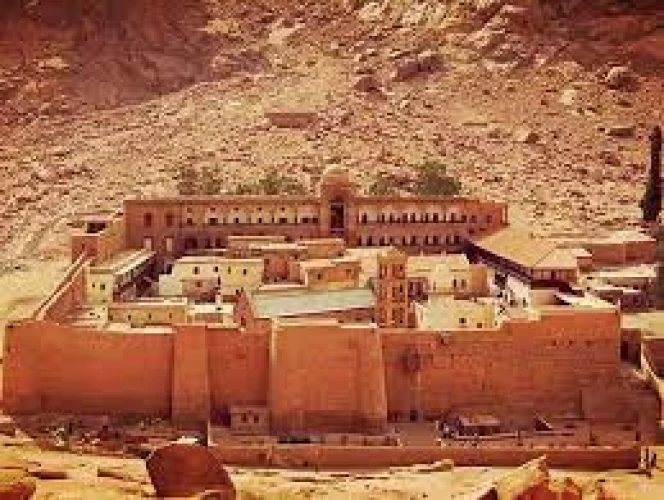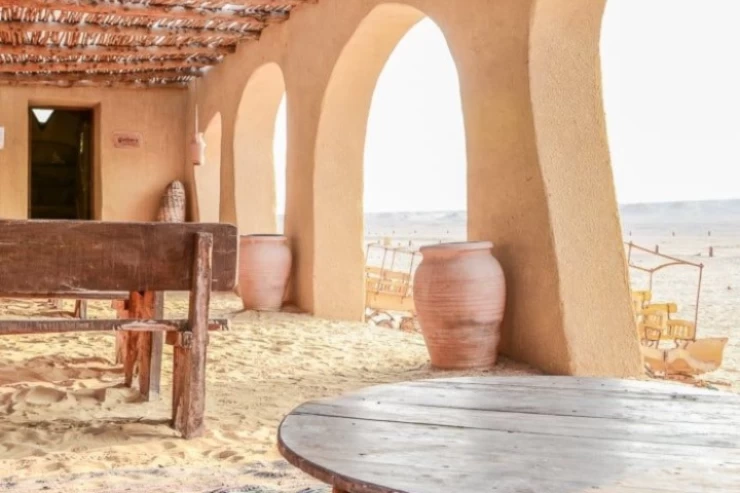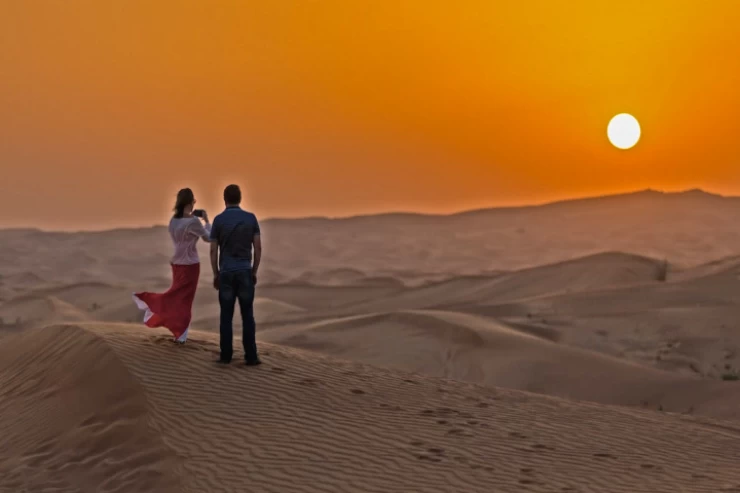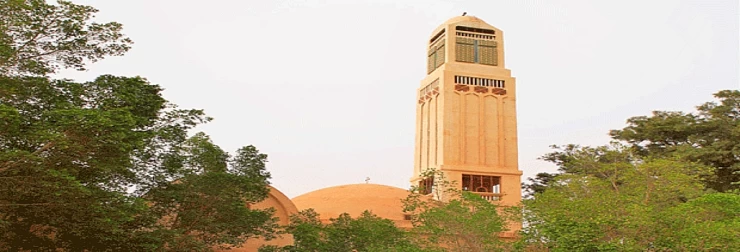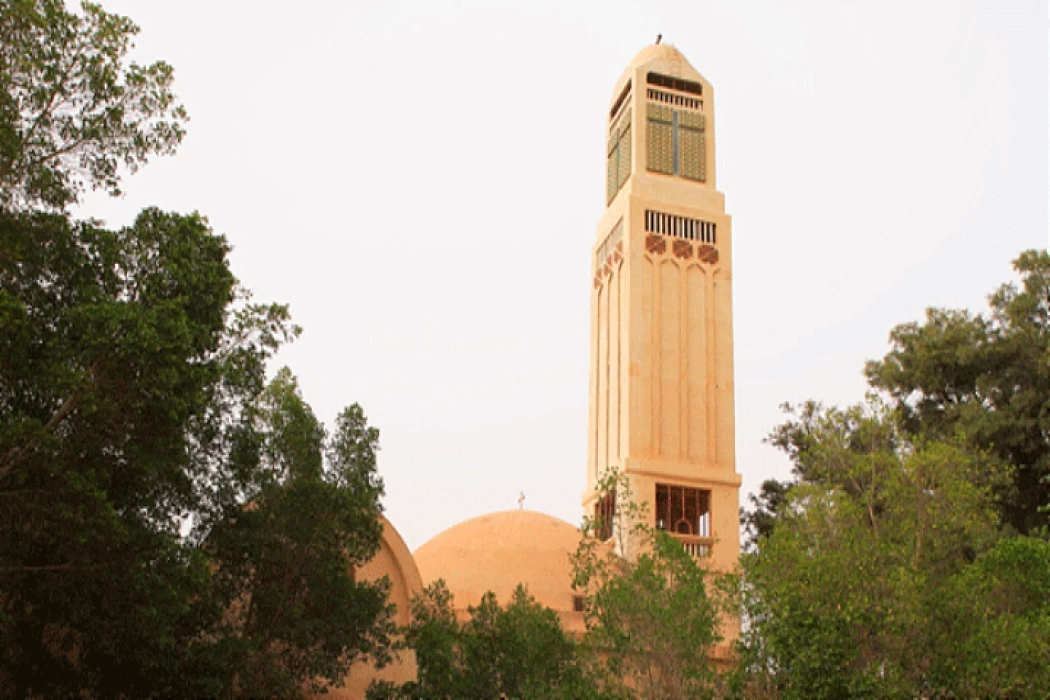
Wadi El-Natrun in Egitto
Wadi El-Natrun in Egitto
Wadi al-Natrun è una delle città del Governatorato di Beheira, situata nella periferia nord-orientale del deserto occidentale egiziano, a circa metà strada tra la strada del deserto che collega il Cairo e Alessandria, e di fronte alla città di Sadat.
Wadi El-Natrun non è una valle nel senso ben noto, ma è bassa nel deserto occidentale. Wadi El-Natrun confina a nord con il Centro Abu al-Matamir e il Centro Badr, e ad est è la città di Sadat, mentre il centro di al-Hammam si trova nel Governatorato di Matruh, a ovest di questa depressione, e infine a sud di esso è la città del 6 ottobre.
Questa zona chiamata Wadi Al-Natroun era di grande importanza durante l'era dei Faraoni, poiché il sale veniva estratto da questa terra e chiamato il sale del natron noto scientificamente come bicarbonato di sodio. Puttana, campo di sale e altri nomi simili.
Ottenne anche un'alta reputazione santa nel cristianesimo, come risultato del passaggio della Sacra Famiglia attraverso di lui per sfuggire al re Erode fino a quando non raggiunse la prima congregazione monastica in essa nel IV secolo d.C., per mano della grande sede che stabilì il monastero di Anba Makar e poi seguito da altri tre monasteri, vale a dire il Monastero di Anba Bishoy e il Monastero di El-Baramos e il Monastero di Syrian, fino a quando il numero di monasteri raggiunse 700 monasteri nella valle fino a quando non iniziarono a ridursi fino ad ora solo quattro monasteri, mentre il resto andò perduto, per questo la valle è considerata una delle aree sacre più importanti per i seguaci della Chiesa copta ortodossa egiziana.
Il turismo a Wadi El-Natrun si concentra in molti monumenti copti, dove iniziò il monachesimo in piccoli villaggi incisi sulle colline, poi furono imposte condizioni naturali agli eremiti per creare complessi convergenti, e da qui iniziò l'idea di riunirsi all'interno di monasteri per provvedere protezione dalle incursioni barbariche, poiché le fortezze interne sono state stabilite in ogni monastero e sono ancora Un elenco esiste finora, e un gran numero di cristiani si sono rifugiati in esso per sfuggire alle lamentele dei romani. Dopo la conquista islamica dell'Egitto, i monaci e Natron andarono dal leader arabo, Amr ibn al-Aas, così li assicurò per la loro vita e la libertà del loro culto e si incaricò di fornire loro ciò di cui avevano bisogno.
Il lago Hamra o Ayoub, come lo chiamano i suoi abitanti, attrae visitatori per il turismo medico perché si distingue per la sua alta salinità e le sue proprietà curative specifiche per i pazienti con malattie della pelle .. e questo lago si trova nel mezzo della strada desertica che collega le città di Alessandria e del Cairo nella regione di Wadi Natrun.
Il deserto arido abbraccia quel lago, caratterizzato da un'estrema salinità. In mezzo a questo lago sgorga un occhio da cui esplode una fonte del cibo più dolce e salutare con una capacità miracolosa di curare le malattie della pelle. Come risultato del flusso di quest'acqua dolce su questo punto estremamente salato, si forma una piastra sfumata dai colori brillanti, che annuncia il potere del Creatore.
Con Cairo Top Tours, puoi fare i migliori viaggi ai monasteri di Wadi El Natroun prenotando tour copti del Cairo dal Cairo o da Alessandria.
Il nostro team vi aiuterà a viaggiare in Egitto e sperimentare il tempo soleggiato del nostro bel paese durante la Pasqua 2024, grazie alla loro vasta conoscenza del turismo egiziano. Puoi personalizzare il tuo pacchetto selezionando uno dei nostri pacchetti di viaggio in Egitto o sfruttare al massimo il tuo tempo in una breve visita, imparando di più sulla storia egiziana e le sue affascinanti storie e vivendola attraverso tour privati al Cairo. Partecipa a uno dei nostri tour economici in Egitto attraverso il deserto del Sahara, come i tour di Siwa dal Cairo, per esempio, o preferibilmente i tour nel Deserto Bianco d'Egitto. Scoprite i nostri tour di un giorno ad Assuan, fate una gita di un giorno da Assuan ad Abu Simbel, o viaggiate via terra e godetevi i nostri tour di un giorno a Luxor per vedere gli incredibili templi di Karnak, il Tempio di Luxor, il Tempio di Hatshepsut, e vedete le meravigliose tombe splendidamente dipinte nella Valle dei Re, questo è il luogo dove i re e i governanti del nuovo regno riposano in pace e imparate i loro riti di mummificazione e sepoltura.
Wadi al-Natrun is one of the cities of Beheira Governorate, located on the northeastern outskirts of the Egyptian Western Desert, about halfway between the desert road linking Cairo and Alexandria, and facing the city of Sadat.
Wadi El-Natrun is not a valley in the well-known sense, but it is low in the Western Desert. Wadi El-Natrun borders to the north the Abu al-Matamir Center and the Badr Center, and to the east is the city of Sadat, while the center of al-Hammam is located in the Matruh Governorate, west of this depression, and finally to the south of it is the city of the Sixth of October.
This area called Wadi Al-Natroun was of great importance during the era of the Pharaohs, as the salt was extracted from this land and called the salt of the Natron known scientifically as sodium bicarbonate. Hooker, salt field, and other such names.
He also obtained a high holy reputation in Christianity, as a result of the passage of the Holy Family through him to escape from King Herod until he reached the first monastic congregation in it in the fourth century AD, at the hands of the great headquarters that established the monastery of Anba Makar and then followed by three other monasteries, namely the Monastery of Anba Bishoy and the Monastery of El-Baramos and the Monastery of Syrian, until the number of monasteries reached 700 monasteries in the valley until they started shrinking to now only four monasteries, while the rest were lost, so the valley is considered one of the most important sacred areas for followers of the Egypt Coptic Orthodox Church.
Tourism in Wadi El-Natrun is concentrated in many Coptic monuments, where monasticism began in small villages engraved in the hills, then natural conditions were imposed on the hermits to set up converging complexes, and from here began the idea of gathering inside monasteries to protect from barbaric raids, as internal fortresses were established in each monastery and they are still A list exists so far, and a large number of Christians have taken refuge in it to escape the grievances of the Romans. After the Islamic conquest of Egypt, monks and Natron came to the Arab leader, Amr ibn al-Aas, so he insured them on their lives and the freedom of their worship and took it upon himself to provide them with what they needed.
Lake Hamra or Ayoub's well as its people call it attracts visitors for medical tourism because it is distinguished by its high salinity and its healing properties specifically for patients with skin diseases..and this lake is located in the middle of the desert road linking the cities of Alexandria and Cairo in the Wadi Natrun region.
The arid desert embraces that lake, which is characterized by extreme salinity. In the middle of this lake, an eye bursts out from which a source of the sweetest and most healthy food with a miraculous ability to heal skin diseases explodes. As a result of the flow of this sweet water on this extremely salty spot, a brilliant colored gradient plate is formed, announcing the power of the Creator.
The most significant monasteries in the region of Wadi El Natrun:
- Monastery of Anba Bishoy:
The Monastery of Anba Bishoy is the largest of the monasteries in Wadi El Natrun. This monastery is named after Anba Bishoy, a disciple of Anba Macarius.
-Monastery of Baramous:
The name of Baramous Monastery goes back to Saints Maximus and Domatius of Rome, two Roman fathers of the fourth century AD.
-Monastery of Abu Macarius
-Monastery of the Virgin Mary of the Syrians
The Monastery of the Virgin Mary of the Syrians is one of the four monasteries remaining in Wadi El Natrun in the Western Desert of Egypt, and it is also the smallest.
This monastery was found in the sixth century AD and was first called “Our Lady of Anba Bishoy” as some monasteries with a double name had been established. The monks established a church next to each main monastery.







